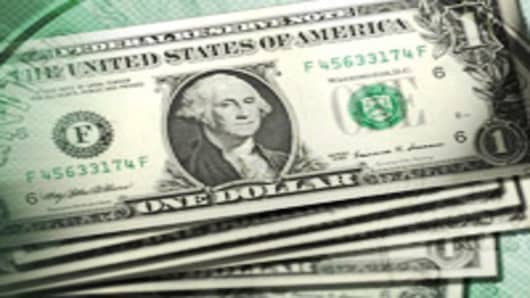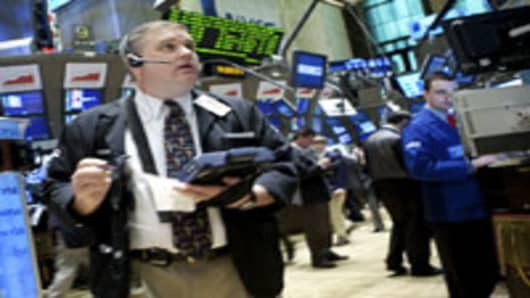With weakness in the dollar expected to continue, investors are rethinking their plans across virtually the entire spectrum of asset classes.
As would be expected with a declining US currency, commodities are soaring, both in the materials themselves and the companies dependent on them.
But the stock market is in a dilemma: The modestly weakened dollar generally helps equities, but a severe downturn in the greenback can be bad.
And investors looking for safe-haven in bonds have to weigh whether the dollar's devaluation—brought on by the government buying up its own debt—presents enough opportunity in yield to outweigh inflation fears.
"The dollar probably deserves to be weak," says Emily Sanders, president of Sanders Financial Management in Atlanta. "However, the fundamental reasons for dollar weaknesses aren't reason to rejoice."
Here's a rundown of how the sliding dollar is shaping various investment decisions:
Stocks
Diminishing returns seems to best fit the relationship between stocks and the shrinking dollar.
The currency's fall has been beneficial to the market so far because it generates inflationary pressure on the weak economy. But too much of a drop and investors will get skittish about the state of the US government and stocks will react likewise.
"Equities do well with mild inflation and very badly with high inflation," says Peter J. Tanous, president and director at Lynx Investment Advisory in Washington, D.C. "Because high inflation hurts everybody, you can't make a general statement that inflation is good for stocks. It's a matter of degree."
The dollar index has slipped 12 percent since March 9, when the stock market hit its most recent low. Since then, stocks have rebounded sharply, and government moves would seem to indicate that a weak-dollar policy is firmly in place—at least in part to boost the corporate fortunes and thus Wall Street.
That has generated worry, though, that there seems to be no end in sight to government moves that effectively drive down the currency's worth, setting off a dollar bubble that could ultimately pummel if not the entire market, then at least particular key sectors.
"The stock market bubble, the Treasury bubble, the real estate bubble--what is the common link between all three bubbles? The dollar," says Lee Markowitz, partner at Continental Capital Advisors in New York. "The end is near for all the bubbles because the dollar is getting so much pressure from currency markets and politicians around the world."
Still, Markowitz isn't ready to set a timetable on when the market could really feel the effects from the dollar's tumble. He believes when the bubble does pop, banks, as well as companies that do most of their business domestically and those with high leverage will be the most hurt.
In the meantime, stocks have been taking only modest hits during pullbacks.
"If the dollar goes into freefall there's an issue, there's a problem, and that problem will show up in equity markets," says Quincy Krosby, chief investment strategist at The Hartford. For now, though, "There's more risk going into the market. The exporters are picking up steam because of the weak dollar."
But economic worries also are keeping investors from stocks.
"It's hard to see a really strong recovery at this point," says Kurt Karl, chief economist at Swiss Re. "The fundamentals wouldn't be pointing toward so much improvement in the equity markets."
In the midst of a general uncertainty about stocks, investors are looking for other areas to put their money.
Commodities
Outside of stocks, gold and oil have been the primary beneficiaries of dollar weakness.
If there's a slam-dunk consensus play emerging from portfolio managers, it is the commodities trade.
"Every investor today should have a dedicated allocation to inflation protection," Tanous says. "You have to get into commodities that have the following two features: Little substitution and growing demand."
In fact, Lynx this week launched a global real asset fund which trades in four commodities: timber gold, water and oil.
Similarly, Markowitz says Continental is strongly interested in gold and silver as portfolio protection against the trends that are hurting the greenback and causing some concern, albeit abated in recent days, that the US could face a credit downgrade.
"We really just want risk-free assets," he says. "We want to be in cash, but you can't be in US-dollar cash. We like gold, silver and buying assets around the world (such as) foreign currencies."
The surge in gold, which was around $965 an ounce Wednesday and within distance of its all-time high just above the $1,000 barrier, in turn has triggered unease about stocks.
"Gold is getting close to a record high. It will be interesting to see how these factors sort themselves out," Rich Berg, CEO at Performance Trust Capital Partners, told CNBC. "We're very perplexed with the level of the stock market...I hate to get in the way but we're very nervous about current valuations."
Treasurys
Because the government has financed so much debt with Treasurys and will continue to do so, investors are staying away from bonds until yields rise further. It's presented a Catch-22 for the government which has been trying to drive up prices so it has to pay less in yields.
Yet the investor trend has been to stay on the short-end of the yield curve, with big foreign investors such as China buying mostly 2-year notes and avoiding long-term commitments to the US.
"What the Chinese are doing is moving some of their long-term assets into short-term so they can make a quick exit strategy," Peter Navarro, an economic at the University of California-Irvine, told CNBC this week. "Plus, they're setting up all these bilateral currency deals with countries around the world so they can back the dollar out. We are literally living on borrowed time."
Adds Markowitz: "When combining the Fed's precarious position with recent fears about the credit rating of the US, the unlimited downside potential of all US assets is becoming clear even to the greatest of bulls."
Ironically, the one thing that could help Treasurys would be a loss of faith in stocks, sending investors to the safe haven of government debt even if they would be losing money in real terms.
Some attribute the various stock rallies over the past three months to technical trading, with computer-generated buy points sending people into stocks regardless of the fundamentals. A strong swoon in the dollar is something that could change that mentality.
"If this is a bull market, why are there so many long faces," says Kathy Boyle, president of Chapin Hill Advisors in New York. "This is not volume going in with expertise. There's cash on the side and with certain trigger points it's going in. People are afraid they're missing the rally."
A rise in yields also would drive investors out of stocks and into Treasurys.
"The sheer amount of bonds we have to issue and the reduced confidence in the economic policies of the US may well demand that the buyers of US government securities will demand higher rates," Tanous says. "The US is still going to be the safest place to invest in the world, but the rate we have to pay will also be a reflection of the present state of our economy. So it's hard to be very bullish on stocks."




